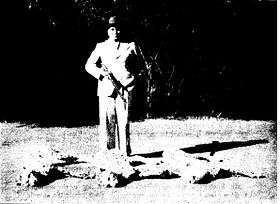Surguja State
| Surguja State | |||||
| Princely State of British India | |||||
| |||||
 | |||||
 | |||||
| Capital | Ambikapur | ||||
| History | |||||
| • | Established | 1613 | |||
| • | Accession to the Union of India | 1948 | |||
| Area | |||||
| • | 1901 | 15,770 km2 (6,089 sq mi) | |||
| Population | |||||
| • | 1901 | 351,011 | |||
| Density | 22.3 /km2 (57.6 /sq mi) | ||||
Surguja State, was one of the main princely states of Central India during the period of the British Raj, even though it was not entitled to any gun salute. Formerly it was placed under the Central India Agency, but in 1905 it was transferred to the Eastern States Agency.
The state spread over a vast mountainous area inhabited by many different people groups such as the Gond, Bhumij, Oraon, Panika, Korwa, Bhuiya, Kharwar, Munda, Chero, Rajwar, Nagesia and Santal.[1] Its former territory lies in the present-day state of Chhattisgarh and its capital was the town of Ambikapur, now the capital of Surguja district.
History

According to tradition,The family of the Maharaja is very ancient, and is stated to belong to the Rajputs of the Lunar race.The present ruling family is said to be descended from a Raksel Raja of Palamau. The state became a British protectorate in 1818 after the Third Anglo-Maratha War. Neighbouring Udaipur State was founded in 1860 as an offshoot of Surguja State. The State was conferred to younger son of Maharaja Amar Singh Deo, to Raja Bindeshwari Prasad Singh Deo CSI. The Chief resided at Partabpur, the headquarters of a tract which he held as a maintenance grant in Surguja, and was a ruler of considerable ability and force of character. In 1871 he aided in the suppression of a rebellion in the Keonjhar State, for which he received the thanks of Government, and gifts of an elephant with gold-embroidered trappings and a gold watch and chain. He obtained the title of Raja Bahadur as a personal distinction, and was also made a Companion of the Most Exalted Order of the Star of India. In 1820 hereditary title of Maharaja was conferred on ruling chief of Surguja. Surguja was one of the Chota Nagpur States[3] and its rulers were Rajputs of the Raksel dynasty. They were the de facto overlords of the smaller states of Udaipur, Jashpur, Koriya (Korea) and Changbhakar that were fringing its territory.[4]
Maharaja Indrajit Singh Deo (1827 - 1879) of Surguja was described as a lunatic by Anglo-Indian writer George Robert Aberigh-Mackay in 1877.[5]
Maharaja Ramanuj Saran Singh Deo, the last ruler of this princely state signed the accession to the Indian Union on 1 January 1948.[6] The Maharaja has the notorious record of having shot and killed a total of 1710 Bengal tigers, the highest known individual score;[7][8] he doesn't hold the official record of shooting into extinction 3 of the last physically recorded Asiatic cheetahs in India, effectively making the species almost locally extinct in 1947, considering that a female was spotted in what was to be the District of Korea in 1951. The last three Asiatic Cheetas were shot by Maharaja Ramanuj Partap Singh Deo of Korea, which is validated in the Journal of the Bombay Natural History Society V.47(1947–48) Page 718 (https://www.biodiversitylibrary.org/item/187063#page/965/mode/1up) [2]
Rulers
The rulers of Surguja State bore the title of 'Raja', although a few had the title of 'Maharaja', including the last head of the state.[9]
Rajas
- 1678 - 1709 Baiha Dadu Singh Deo
- 1709 - 1728 Balbhadra Singh I Deo
- 1728 - 1749 Jaswat Singh Deo
- 1749 - 1758 Bahadur Sigh Deo
- 1760 - 17.. Sheo Singh Deo
- 1792 - 1799 Ajit Singh Deo
- 1799 - 1800 Balbhadra Singh II Deo (1st time)
- 1800 - 1813 Lal Singram Singh Deo
- 1813 - 1816 Balbhadra Singh II Deo (2nd time)
- 1816 - 1820 interregnum
- 1820 - 1851 Lal Amar Singh Deo (from 1820 with hereditary style Maharaja)
- 1851 - 25 Mar 1879 Indrajit Singh Deo (b. 1827 - d. 1879)
- 25 Mar 1879 – 31 Dec 1917 Raghunath Saran Singh Deo (b. 1860 - d. 1917) (from 1887 with personal style Maharaja; from 1896 Maharaja Bahadur)
- 31 Dec 1917 - 1918 Ramanuj Saran Singh Deo (b. 1895 - d. 1965) (with hereditary style Maharaja)
Maharaja
- 1820 - 1851 Lal Amar Singh Deo (from 1820 with hereditary style Maharaja)
- 1918 - 15 Aug 1947 Ramanuj Saran Singh Deo
See also
References
- ↑ The Tribes and Castes of the Central Provinces of India
- 1 2 Divyabhanusinh (1999). The End of a Trail: the Cheetah in India. Banyan Books, New Delhi.
- ↑

- ↑ Malleson, G. B.: An historical sketch of the native states of India, London 1875, Reprint Delhi 1984
- ↑ G. R. Aberigh-Mackay, The Native Chiefs and Their States in 1877:A Manual of reference.
- ↑ Rajput Provinces of India - Surguja (Princely State)
- ↑ The scent of shikar
- ↑ Tiger Hunting in India 1924
- ↑ Princely States of India
External links
